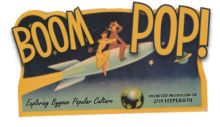 Today marks the 50th Anniversary of one of Walt Disney's most celebrated films in the True-Life Adventure series, White Wilderness. Released on August 12, 1958, it was a distinct commercial success and would go on to win that year's Academy Award for feature length documentary.
Today marks the 50th Anniversary of one of Walt Disney's most celebrated films in the True-Life Adventure series, White Wilderness. Released on August 12, 1958, it was a distinct commercial success and would go on to win that year's Academy Award for feature length documentary.It would gain a degree of notoriety a quarter century later, when in 1982, a Canadian Broadcasting Company documentary on animal cruelty would accuse the filmmakers of staging scenes and perpetuating the myths of lemming suicides. Though commendable for its overall expose of animal cruelty in motion picture making, the report tended to exaggerate Disney's propagation of the lemming suicide myth.
The makers of the True-Life series did in fact play hard and loose with filming and footage. But those individuals have long made no secret of such efforts and documentaries and interviews on the recent True-Life Adventure DVDs attest to their forthrightness. While the lemming scene in White Wilderness was admittedly staged, it has since been misrepresented rather frequently, accusing the Disney filmmakers of forcing the creatures over the cliff to their deaths. As noted by both the film's narrator Winston Hibler and other academic sources, the lemmings (based primarily on those indigenous to Norway) in fact die from exhaustion from extended swimming rather than from the plunge into the water. In his narration, Hibler notes the suicide myth in its proper context. In an interview on the CBC program, Roy E. Disney mistakenly cited a "seven-year suicide cycle." The program then proceeded to debunk this statement of lemming misinformation. A simple viewing of the film demonstrates that Disney's statement did not reflect the actual content presented in White Wilderness.
On the program, CBC reporter Bob McKeown cited no specific evidence that the lemmings in White Wilderness were killed as a result of the filmmakers' staging of the sequence, but did make that suggestion via the film's own footage. That coupled with a statement by Roy E. Disney, who by his own admission had no direct knowledge of the lemming sequence, that "we may have lost a few lemmings," more or less became the indictment that McKeown was looking for. While the Disney Studios' technical and philosophical approaches to making True-Life Adventure films were certainly questionable, especially when you consider the "True-Life"moniker, the lemming controversy associated with White Wilderness seems potentially overblown. It is interesting to note that fifty years later, staging techniques continue to be used in the filming of nature documentaries.
 Despite said controversies, White Wilderness contains much spectacular and remarkable footage. It remains a distinct spiritual and technical forerunner to current nature documentaries, most especially the much lauded Planet Earth series. In fact, the first episode of Planet Earth features scenes of a mother polar bear and her cubs that is remarkably similar to footage in White Wilderness.
Despite said controversies, White Wilderness contains much spectacular and remarkable footage. It remains a distinct spiritual and technical forerunner to current nature documentaries, most especially the much lauded Planet Earth series. In fact, the first episode of Planet Earth features scenes of a mother polar bear and her cubs that is remarkably similar to footage in White Wilderness.Images © Walt Disney Company



















0 comments:
Post a Comment